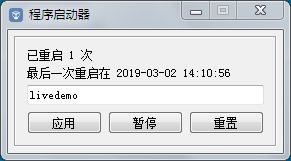Qt编写守护程序保证程序一直运行(开源)
没有任何人敢保证自己写的程序没有任何BUG,尤其是在商业项目中,程序量越大,复杂度越高,出错的概率越大,尤其是现场环境千差万别,和当初本地电脑测试环境很可能不一样,有很多特殊情况没有考虑到,如果需要保证程序7*24小时运行,则需要想一些办法能够让程序死了能够活过来,在嵌入式linux上,大部分会采用看门狗的形式来处理,程序打开看门狗驱动后,定时喂狗,一旦超过规定的时间,则硬件软复位等。这种方式相对来说比较可靠,如果需要在普通PC机上运行怎办呢?本篇文章提供一个软件实现守护进程的办法,原理就是udp通信,单独写个守护进程程序,专门负责检测主程序是否存在,不存在则启动。主程序只需要启动live类监听端口,收到hello就回复ok就行。
为了使得兼容任意程序,特意提炼出来共性,增加了多种设置。
1:可设置检测的程序名称。
2:可设置udp通信端口。
3:可设置超时次数。
4:自动记录已重启次数。
5:自动记录最后一次重启时间。
6:是否需要重新刷新桌面。
7:可重置当前重启次数和最后重启时间。
8:自动隐藏的托盘运行或者后台运行。
9:提供界面设置程序名称已经开启和暂停服务。
完整代码下载:https://download.csdn.net/download/feiyangqingyun/10989964



守护进行核心代码:
#pragma execution_character_set("utf-8")
#include "frmmain.h"
#include "ui_frmmain.h"
#include "qtimer.h"
#include "qudpsocket.h"
#include "qsharedmemory.h"
#include "qprocess.h"
#include "qdatetime.h"
#include "qapplication.h"
#include "qdesktopservices.h"
#include "qmessagebox.h"
#if (QT_VERSION > QT_VERSION_CHECK(5,0,0))
#include "qstandardpaths.h"
#endif
#include "app.h"
frmMain::frmMain(QWidget *parent) : QWidget(parent), ui(new Ui::frmMain)
{
ui->setupUi(this);
this->initForm();
}
frmMain::~frmMain()
{
delete ui;
}
void frmMain::changeEvent(QEvent *event)
{
//隐藏当前界面,最小化到托盘
if(event->type() == QEvent::WindowStateChange) {
if(windowState() & Qt::WindowMinimized) {
hide();
}
}
QWidget::changeEvent(event);
}
void frmMain::initForm()
{
count = 0;
ok = false;
//每秒钟定时询问心跳
timerHeart = new QTimer(this);
timerHeart->setInterval(2000);
connect(timerHeart, SIGNAL(timeout()), this, SLOT(sendHearData()));
//从6050端口开始,如果绑定失败则将端口加1,直到绑定成功
udp = new QUdpSocket(this);
int port = 6050;
while(!udp->bind(port)) {
port++;
}
connect(udp, SIGNAL(readyRead()), this, SLOT(readData()));
if (App::TargetAppName.isEmpty()) {
ui->btnStart->setText("启动");
ui->btnStart->setEnabled(false);
timerHeart->stop();
} else {
ui->btnStart->setText("暂停");
ui->btnStart->setEnabled(true);
timerHeart->start();
}
ui->txtAppName->setText(App::TargetAppName);
ui->txtAppName->setFocus();
}
void frmMain::sendHearData()
{
udp->writeDatagram("hello", QHostAddress::LocalHost, App::TargetAppPort);
//判断当前是否没有回复
if (!ok) {
count++;
} else {
count = 0;
ok = false;
}
//如果超过规定次数没有收到心跳回复,则超时重启
if (count >= App::TimeoutCount) {
timerHeart->stop();
QSharedMemory mem(App::TargetAppName);
if (!mem.create(1)) {
killApp();
}
QTimer::singleShot(1000 , this, SLOT(killOther()));
QTimer::singleShot(3000 , this, SLOT(startApp()));
QTimer::singleShot(4000 , this, SLOT(startExplorer()));
}
}
void frmMain::killApp()
{
QProcess *p = new QProcess;
p->start(QString("taskkill /im %1.exe /f").arg(App::TargetAppName));
}
void frmMain::killOther()
{
QProcess *p = new QProcess;
p->start(QString("taskkill /im %1.exe /f").arg("WerFault"));
//重建缓存,彻底清除托盘图标
if (App::ReStartExplorer) {
QProcess *p1 = new QProcess;
p1->start("taskkill /f /im explorer.exe");
}
}
void frmMain::startApp()
{
if (ui->btnStart->text() == "开始" || ui->btnStart->text() == "启动") {
count = 0;
return;
}
QProcess *p = new QProcess;
p->start(QString("\"%1/%2.exe\"").arg(qApp->applicationDirPath()).arg(App::TargetAppName));
count = 0;
ok = true;
timerHeart->start();
App::ReStartCount++;
App::ReStartLastTime = QDateTime::currentDateTime().toString("yyyy-MM-dd HH:mm:ss");
App::writeConfig();
ui->labCount->setText(QString("已重启 %1 次").arg(App::ReStartCount));
ui->labInfo->setText(QString("最后一次重启在 %1").arg(App::ReStartLastTime));
}
void frmMain::startExplorer()
{
//取得操作系统目录路径,指定操作系统目录下的explorer程序,采用绝对路径,否则在64位操作系统下无效
#if (QT_VERSION > QT_VERSION_CHECK(5,0,0))
QString str = QStandardPaths::writableLocation(QStandardPaths::ApplicationsLocation);
#else
QString str = QDesktopServices::storageLocation(QDesktopServices::ApplicationsLocation);
#endif
if (App::ReStartExplorer) {
str = QString("%1\\Windows\\explorer.exe").arg(str.mid(0, 2));
QProcess *p = new QProcess(this);
p->start(str);
}
}
void frmMain::readData()
{
QByteArray tempData;
do {
tempData.resize(udp->pendingDatagramSize());
udp->readDatagram(tempData.data(), tempData.size());
QString data = QLatin1String(tempData);
if (data.right(2) == "OK") {
count = 0;
ok = true;
}
} while (udp->hasPendingDatagrams());
}
void frmMain::on_btnOk_clicked()
{
App::TargetAppName = ui->txtAppName->text();
if (App::TargetAppName == "") {
QMessageBox::critical(this, "提示", "应用程序名称不能为空!");
ui->txtAppName->setFocus();
return;
}
App::writeConfig();
ui->btnStart->setEnabled(true);
}
void frmMain::on_btnStart_clicked()
{
count = 0;
if (ui->btnStart->text() == "暂停") {
timerHeart->stop();
ui->btnStart->setText("开始");
} else {
timerHeart->start();
ui->btnStart->setText("暂停");
}
}
void frmMain::on_btnReset_clicked()
{
App::ReStartCount = 0;
App::ReStartLastTime = "2019-01-01 12:00:00";
App::writeConfig();
ui->txtAppName->setText(App::TargetAppName);
ui->labCount->setText(QString("已重启 %1 次").arg(App::ReStartCount));
ui->labInfo->setText(QString("最后一次重启在 %1").arg(App::ReStartLastTime));
QMessageBox::information(this, "提示", "重置配置文件成功!");
}
使用主程序核心代码:
#include "applive.h"
#include "qmutex.h"
#include "qudpsocket.h"
#include "qstringlist.h"
#include "qapplication.h"
#include "qdatetime.h"
#include "qdebug.h"
#define TIMEMS qPrintable(QTime::currentTime().toString("HH:mm:ss zzz"))
QScopedPointer AppLive::self;
AppLive *AppLive::Instance()
{
if (self.isNull()) {
QMutex mutex;
QMutexLocker locker(&mutex);
if (self.isNull()) {
self.reset(new AppLive);
}
}
return self.data();
}
AppLive::AppLive(QObject *parent) : QObject(parent)
{
udpServer = new QUdpSocket(this);
QString name = qApp->applicationFilePath();
QStringList list = name.split("/");
appName = list.at(list.count() - 1).split(".").at(0);
}
void AppLive::readData()
{
QByteArray tempData;
do {
tempData.resize(udpServer->pendingDatagramSize());
QHostAddress sender;
quint16 senderPort;
udpServer->readDatagram(tempData.data(), tempData.size(), &sender, &senderPort);
QString data = QLatin1String(tempData);
if (data == "hello") {
udpServer->writeDatagram(QString("%1OK").arg(appName).toLatin1(), sender, senderPort);
}
} while (udpServer->hasPendingDatagrams());
}
bool AppLive::start(int port)
{
bool ok = udpServer->bind(port);
if (ok) {
connect(udpServer, SIGNAL(readyRead()), this, SLOT(readData()));
qDebug() << TIMEMS << "Start AppLive Ok";
}
return ok;
}
void AppLive::stop()
{
udpServer->abort();
disconnect(udpServer, SIGNAL(readyRead()), this, SLOT(readData()));
}